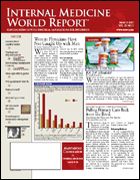Publication
Article
Internal Medicine World Report
Carnitine Improves Symptoms in Patients with Diabetic Neuropathy
Carnitine Improves Symptoms in Patients with Diabetic Neuropathy
Pain, Vibration Perception, and Nerve-Fiber Regeneration Significantly Improved
By David S. MacDougall
DETROIT—Dietary supplementation with acetyl-L-carnitine (ALC) improves pain, vibratory perception, and nerve-fiber regeneration in patients with diabetic neuropathy, new study findings suggest (Diabetes Care. 2005;28:96-101).
Previous studies have shown that diabetic patients are deficient in ALC. Use of ALC has been shown to correct perturbations of neural sodium and potassium transport, lipid peroxidation, and other metabolic abnormalities associated with diabetic polyneuropathy. In addition, clinical studies have shown that ALC is effective in the treatment of peripheral neuropathies associated with HIV infection and other disorders, but the effects of ALC in patients with diabetic neuropathy has not been known.
Anders A.F. Sima, MD, PhD, of Wayne State University, and colleagues evaluated data from 2 multicenter, double-blind, placebo-controlled, randomized clinical trials. The studies examined the effects of treatment with ALC (500 or 1000 mg tid) for 52 weeks in a total combined population of 1346 patients with type 1 or 2 diabetes and polyneuropathy.
The design of both studies was identical, and the data were analyzed separately and in combination. Efficacy end points included clinical symptom scores, vibration perception thresholds, nerve conduction velocities, sural nerve morphometry, and a visual analogue scale for assessment of the most bothersome symptom at baseline, most notably pain.
Morphometric evaluations of nerve biopsies revealed significant increases, in the combined 500 mg ALC group, in several parameters, including total myelinated fiber number, mean fiber size, fiber density, fiber occupancy, axon-to-myelin ratio, fiber numbers, and regenerating clusters. No significant differences were evident between the 500 and 1000 mg ALC groups.
Vibration perception threshold improved significantly in the fingers in both ALC groups. Significantly greater reductions in vibration perception thresholds were observed in patients age <55 years and in those with body mass index <30 kg/m2, type 2 diabetes, or with hemoglobin A1c <8.5%.
Evaluation of clinical symptoms in the combined cohorts showed greater mean improvements in both ALC-treated groups compared with placebo at 52 weeks, with no significant differences between the 500- and 1000-mg ALC groups. None of the sural nerve conduction velocity or amplitude measures showed any significant changes in patients treated with ALC.
Pain was reported as the most bothersome symptom at baseline by 27% of the patients. Visual analogue scale scores for pain showed significant improvement at both 26 (P = .031) and 52 weeks (P = .025) in 1 study and in the combined cohort taking 1000 mg ALC 3 times daily.
The most common emergent adverse effects were pain, paresthesia, hyperesthesia, and gastrointestinal symptoms. In the total population, pain, paresthesia, and hyperesthesia were reported by significantly fewer patients taking 1000 mg ALC compared with placebo.
“In the present study, ALC treatment presumably inhibited active fiber degeneration, as suggested by the morphometric data, thereby minimizing dyesthetic pain,” the researchers wrote. “These studies demonstrate that ALC treatment is efficacious in alleviating symptoms, particularly pain, and improves nerve fiber regeneration and vibration perception in patients with established diabetic neuropathy.”
